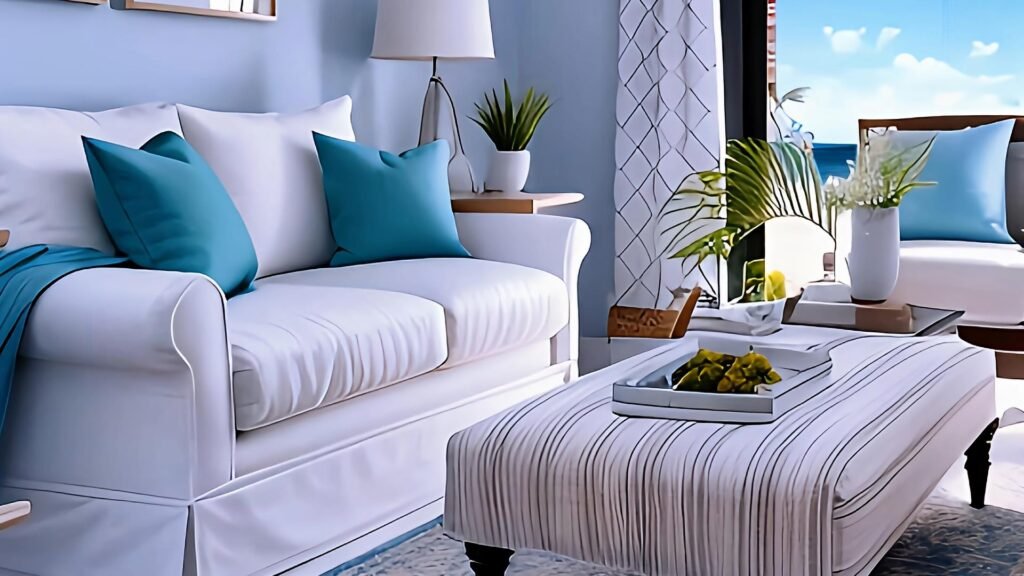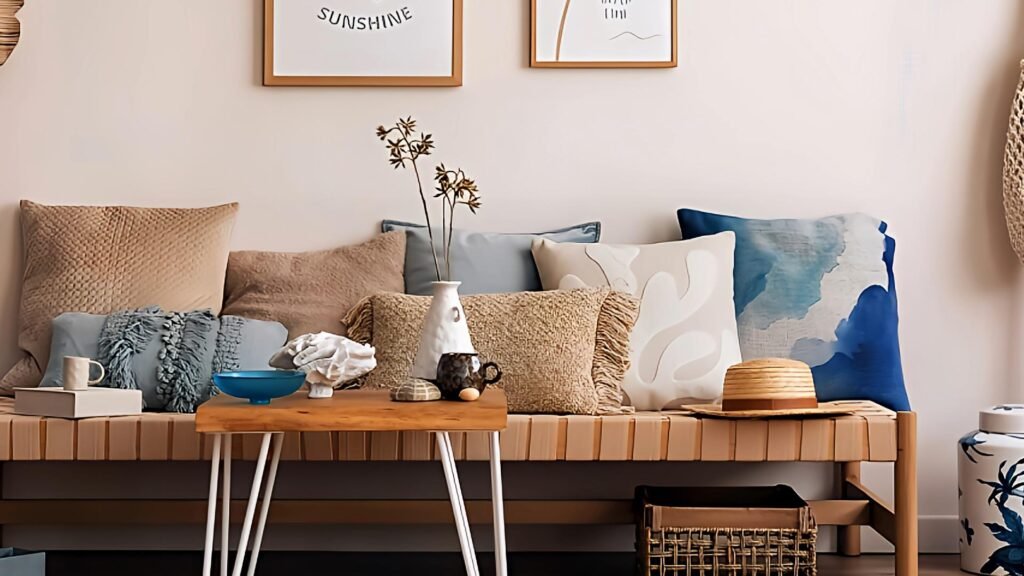Explore the distinct characteristics of nautical and coastal design styles. Learn how nautical design draws inspiration from maritime elements like anchors and ship wheels with a color palette of navy blue, white, and red. Discover how coastal design uses soft blues, greens, and sandy neutrals to create a light, airy atmosphere with natural materials like driftwood and rattan. Find out how to choose the right style for your space and create a calming, rejuvenating environment inspired by the sea.
Introduction to Nautical and Coastal Design Styles
Nautical and coastal design styles, while often conflated, are distinctive in their principles, themes, and historical contexts. Both styles draw inspiration from the sea, yet each does so in unique ways that reflect different aspects of maritime life and coastal living.

Nautical design, also referred to as maritime or seafaring style, is deeply rooted in the traditions of sailors and seafarers. This style evokes the essence of life at sea, emphasizing elements such as ship wheels, anchors, and navigation charts. The color palette typically revolves around navy blue, white, and touches of red or gold, reminiscent of naval uniforms and ship decor. Nautical design often includes materials like polished wood, brass, and robust fabrics such as canvas and sailcloth, which are not only aesthetically pleasing but also practical and durable.
Please read our article watch the newly uploaded video from our YouTube channel:
“Grig Stamate – Interior Design Solutions”
https://www.youtube.com/@GrigStamate
Sailor or Sand: Unveiling the Secrets of NAUTICAL vs. COASTAL Design Styles (video)
Here, you can see other related videos from our channel:
Best Nautical Interior Design Style and Coastal Decoration Ideas (video)
35 Laidback COASTAL Living Room Design Ideas (video)
In contrast, coastal design, also known as beach or seaside style, encapsulates the relaxed and breezy atmosphere of coastal living. This style prioritizes light, airy spaces with a focus on natural light and open layouts. The color scheme leans towards soft, pastel hues like sandy beiges, ocean blues, and seafoam greens, mimicking the natural surroundings of coastal landscapes. Coastal design often incorporates elements such as weathered wood, wicker furniture, and nautical motifs, but in a more understated manner compared to the bold and structured nautical style.

Historically, both styles have evolved from practical origins into popular interior design choices. Nautical design has its roots in the functional and durable interiors of ships, while coastal design draws from the serene and casual ambiance of seaside cottages. Over time, these styles have been adapted to modern tastes, blending traditional elements with contemporary sensibilities.
Despite their differences, nautical and coastal designs share a common thread: a connection to the sea and a desire to bring the tranquility and beauty of marine environments into the home. This shared foundation has contributed to their enduring popularity in modern interior design, where they offer a timeless appeal that resonates with those seeking a serene and stylish living space.

Key Elements of Nautical Design Style
The nautical design style is deeply rooted in the essence of maritime adventures, capturing the spirit of the sea through a carefully curated selection of colors, materials, and decorative elements. This design style predominantly utilizes a color palette that mirrors the ocean and nautical themes. The primary colors are navy blue and white, often accentuated with hints of red to add a vibrant touch. These colors not only echo the hues of the sea and sky but also evoke a sense of calmness and freshness, reminiscent of open waters and coastal environments.
Materials and textures play a crucial role in bringing the nautical design style to life. Wood is a fundamental element, often featured in furniture and flooring, providing a warm and organic feel akin to that of a ship’s deck. Rope is another significant material, frequently used in various decorative items such as curtain tiebacks, lamp bases, or even wall art, adding a rustic and authentic maritime touch. Brass, with its classic and polished appearance, is commonly incorporated in fixtures and fittings, evoking the traditional hardware used on ships.
Decorative elements are pivotal in reinforcing the nautical theme and creating a cohesive design. Items such as anchors, ship wheels, and maritime maps are iconic symbols that instantly transport one to the world of seafaring. These elements can be incorporated in various forms, from wall art and cushions to more functional items like clocks and mirrors. Additionally, the use of striped patterns, particularly in textiles, is a hallmark of nautical design, further enhancing the theme’s visual appeal.
Overall, the combination of these key elements—color palette, materials, textures, and decorative items—works synergistically to evoke a sense of being on a ship or near the sea. This creates an immersive environment that captures the adventurous spirit of maritime life, making nautical design a timeless and captivating style choice.
Key Elements of Coastal Design Style
Coastal design style, often synonymous with relaxation and tranquility, is characterized by its light and airy color schemes. Predominantly, the palette includes sandy beige, soft blues, and whites, which mimic the natural seaside environment. These colors reflect the essence of the beach, creating an inviting and serene ambiance that is both refreshing and calming.
The materials commonly used in coastal design further enhance this relaxed atmosphere. Natural fibers such as cotton, linen, and jute are frequently chosen for their breathable and organic qualities. Light woods, including oak, pine, and cedar, are preferred for furniture and flooring, adding to the airy feel of the space. Wicker items, from baskets to furniture pieces, contribute a rustic yet sophisticated touch, blending seamlessly with the overall design.
Decorative elements play a crucial role in bringing the coastal theme to life. Seashells, driftwood, and oceanic art are staples in coastal design. These items not only serve as beautiful decor but also as reminders of the seaside, evoking memories of beachcombing and ocean breezes. Wall art depicting marine life or seascapes, alongside nautical-inspired accessories like ropes and anchors, further reinforce the coastal vibe.
All these elements work harmoniously to create a space that feels like a continuous extension of the beach. The light color palette, combined with natural materials and beach-themed decor, results in a cohesive and tranquil environment. Coastal design is more than just a style; it’s an invitation to experience the calm and rejuvenating atmosphere of the shore every day.
Choosing Between Nautical and Coastal: Tips and Inspirations
When embarking on a home design journey, selecting between nautical and coastal styles can be both exciting and challenging. Each style offers distinct attributes that cater to different tastes and space requirements. Understanding these nuances can help you make an informed decision that aligns with your personal preferences.
The nautical design style evokes the spirit of the sea with bold, maritime elements. Think of deep navy blues, crisp whites, and striking reds paired with nautical motifs such as anchors, ropes, and ship wheels. This style works exceptionally well in spaces where a strong, thematic presence is desired. For instance, a nautical-themed living room might feature a navy blue sofa accented with white and red cushions, complemented by a ship wheel wall décor and a braided rope rug.
In contrast, the coastal design style is more subdued and airy, drawing inspiration from the beach and its surroundings. This style embraces soft, soothing colors like sandy beiges, light blues, and seafoam greens. Natural materials such as driftwood, wicker, and linen are staples in coastal design. A coastal-inspired bedroom might include a light blue bedspread, wicker furniture, and accents like seashells or beach glass. This style is perfect for creating a relaxed, breezy atmosphere.
For those who appreciate elements of both styles, mixing and matching can yield a personalized and harmonious look. Combine the structured elements of nautical design with the soft, natural touches of coastal décor to create a balanced space. For example, a dining room could feature a navy blue table runner with coastal-themed tableware and wicker chairs, seamlessly blending the maritime and beachy vibes.
Finding inspiration for nautical and coastal designs is easier than ever. Design magazines, websites, and social media platforms like Pinterest and Instagram are treasure troves of ideas. Look for themed boards and posts to discover how others have successfully implemented these styles. By exploring various sources, you can gather a wealth of ideas and tips to create a space that reflects your unique taste and lifestyle.
Other related posts from our website:
Let’s see here, three of them:
https://howtobuildahouseblog.com/best-nautical-interior-design-style-and-coastal-decoration-ideas/
https://howtobuildahouseblog.com/35-laidback-coastal-living-room-design-ideas/
https://howtobuildahouseblog.com/interior-styles-which-living-room-style-suits-you/
Thank you so much for your attention.
We also sincerely hope you like our ideas from this post, and you have also enjoyed our uploaded YouTube video.
See you next time at another article.
Thank you so much for your time. Bye now!


